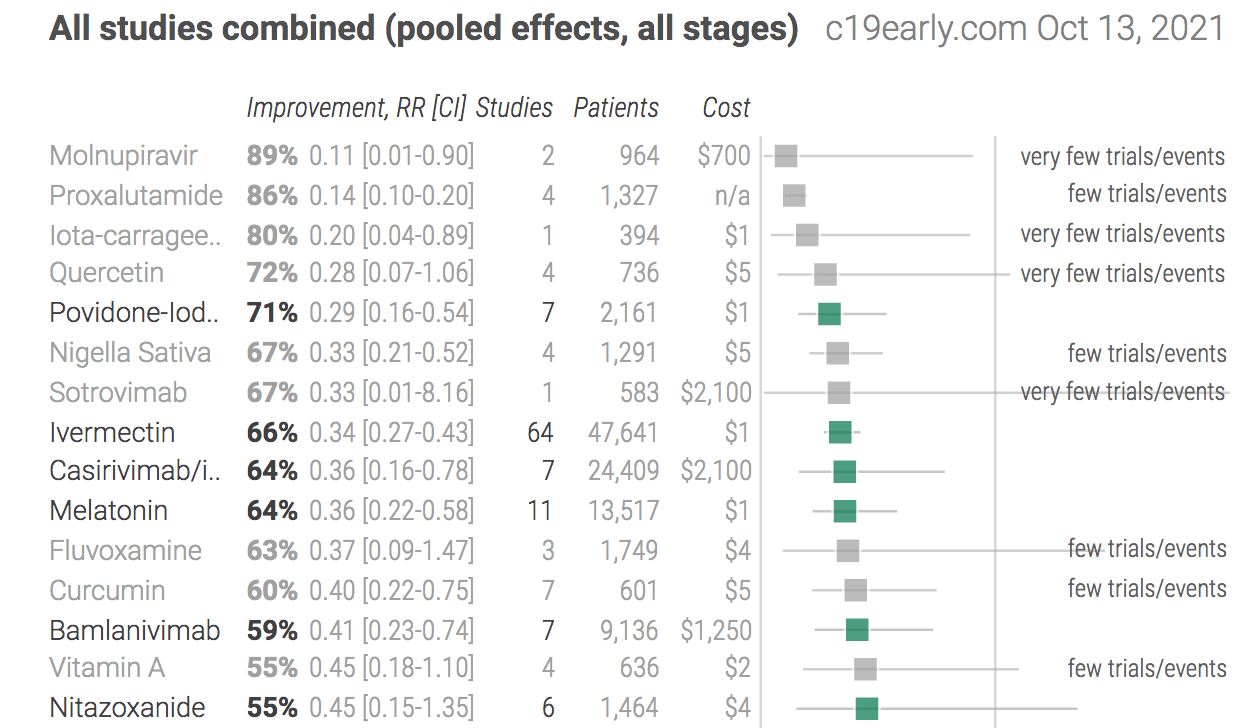The Cover Up by the Medical Establishment on Vitamin D Levels
Executive Summary
- Vitamin D or D3 is hugely important for health, however, it has been deliberately de-emphasized by health authorities and the medical establishment.

Introduction
While reviewing the treatments for covid, I found something of interest regarding the natural supplements that were as effective as drugs like Ivermectin and Vitamin D. I cover the logic for the supplements selected in the article Why Are Some Supplements Treatments Against Covid?
This article explains the clear de-emphasis on Vitamin D by health authorities.
Our References for This Article
If you want to see our references for this article and related Brightwork articles, visit this link.
Treatments for Covid
The following screenshots are from the website C19 Early, which tracks treatments for covid. Note the treatment name and then the improvement versus covid right next to it. The following significant value is the number of studies performed.


Most of the treatments in the table are drugs, and however, C19 Early also includes natural substances in the comparison table. I noted that the following natural supplements were often as effective as the drug treatments.
The logic that flowed from the table was to take supplements that showed a benefit against covid. These items address diet deficiencies and, therefore, are desirable to improve one’s immune system.
One of the most important of these vitamins also happens to be one that people are generally quite deficient in. This is Vitamin D.
Vitamin D3 (Aka Vitamin D)
Vitamin D is explained in this video. It also explains that the medical and pharmaceutical companies promoted very low levels of recommended Vitamin D is still being used. The evidence is that much higher levels of Vitamin D are necessary for the proper functioning of the immune system, but the FDA is not interested in updating their RDAs with this evidence. The study states that the medical establishment has ignored the studies on Vitamin D. The video states that the information on Vitamin D has not been updated by health authorities for 100 years.
- Dr. Campbell states that he does not know why the recommended levels have not been updated. He calls the fact they don’t is a form of negligence.
- But I believe he does know. It is due to pharmaceutical interests infecting public health. Dr. Campbell may be afraid of being punished by YouTube for saying why the Vitamin D RDA has not been increased to match the findings in the literature.
The video is absolutely fascinating and contains a deceptively large amount of information presented in a very effective way.
This study is being reviewed in the video by Dr. John Campbell (Doctorate in Nursing), which is consistent with a book I am relying on by Jeff T Bowles on Vitamin D3. This is explained also in the following quotation.
In a letter published last week in the journal Nutrients the scientists confirmed a calculation error noted by other investigators, by using a data set from a different population.
“Both these studies suggest that the IOM underestimated the requirement substantially,” said Garland. “The error has broad implications for public health regarding disease prevention and achieving the stated goal of ensuring that the whole population has enough vitamin D to maintain bone health.”
The recommended intake of vitamin D specified by the IOM is 600 IU/day through age 70 years, and 800 IU/day for older ages. “Calculations by us and other researchers have shown that these doses are only about one-tenth those needed to cut incidence of diseases related to vitamin D deficiency,” Garland explained.
Robert Heaney, M.D., of Creighton University wrote: “We call for the NAS-IOM and all public health authorities concerned with transmitting accurate nutritional information to the public to designate, as the RDA, a value of approximately 7,000 IU/day from all sources.”
“This intake is well below the upper level intake specified by IOM as safe for teens and adults, 10,000 IU/day,” Garland said. Other authors were C. Baggerly and C. French, of GrassrootsHealth, a voluntary organization in San Diego CA, and E.D. Gorham, Ph.D., of UC San Diego. – Science Daily
And also supported by this quote.
It’s now known that vitamin D is necessary not only for healthy bones but for health throughout the body. As a powerful epigenetic regulator, vitamin D influences that activity of more than 2,500 genes, and vitamin D receptors are present all over the body, including in the intestine, pancreas, prostate and immune system cells.7 Vitamin D plays a role in numerous diseases, including:
Cancer
Diabetes
Acute respiratory tract infections
Chronic inflammatory diseases
Autoimmune diseases such as multiple sclerosisVitamin D receptors are present in nearly all cells of the human immune system, including monocytes/macrophages, T cells, B cells, natural killer cells and dendritic cells. Vitamin D has multiple actions on the immune system, including enhancing the production of antimicrobial peptides by immune cells, reducing damaging pro-inflammatory cytokines and promoting the expression of anti-inflammatory cytokines.
Many COVID-19 therapeutics are focused on viral elimination instead of modulating the hyper-inflammation often seen in the disease. In fact, uncontrolled immune response has been suggested as a factor in disease severity, making immunomodulation “an attractive potential treatment strategy.” – The Epoch Times
Vitamin D is also credited with slowing the aging process.
What is Vitamin D?
- Vitamin D is not actually a vitamin. It is a fat-soluble prohormone, which is what the body uses to create a hormone.
- It alters the expression in many genes.
- This hormone communicates the change of season to the body — and tells the body whether to prepare for winter and to conserve resources or to use more resources.
The fact that Vitamin D is a prohormone is shocking to many, as it should be, as it is called a vitamin. This has a confusing history but also is responsible for significant misunderstandings due to this misnaming.
The War on Vitamin D
There has been a long-term strategy by the medical establishment to dissuade people from taking Vitamin D supplements. This has included making up false claims around Vitamin D toxicity.
The following quote is a perfect example of this attempt to de-emphasize.
Nearly nine out of 10 upstate New Yorkers have no medical reason to have their vitamin D levels tested, yet health care providers and patients continue to frequently request the test, according to an analysis released today by Excellus BlueCross BlueShield.
Last year, 641,000 upstate New Yorkers had their vitamin D levels tested, and about 42 percent did so without a medical indication for it. Typically, only people with certain conditions, including but not limited to osteoporosis, kidney and liver disease, malabsorption syndromes, bone disorders and certain endocrine conditions, are candidates for testing. Older adults and some pregnant or lactating women also can expect to have their doctors recommend vitamin D testing.
This makes no sense. The WHO states that around 90% of people are deficient in Vitamin D. So why would a test for Vitamin D not be warranted? Observe what Blue Cross considers a “medical indication” for Vitamin D, which is some type of disease. However, Vitamin D deficiency is the norm. Yet, Blue Cross only considers a specific medical condition to be a reason to get a Vitamin D test. If this does not demonstrate the lack of orientation around prevention by the establishment medical system, I don’t know what else could illustrate this. Something else curious and inconsistent is that the medical system is known for ordering large numbers of unnecessary tests either to increase the utilization of hospital equipment or to practice defensive medicine. These diagnostic tests are extremely expensive in most cases. However, establishment medicine does not critique these very expensive and unnecessary tests but shows concern for a relatively inexpensive test for Vitamin D deficiency.
The comment continues…
Widespread testing is associated with potentially unnecessary treatments with supplements, retesting and increased medical costs. On average, a vitamin D deficiency test can cost $50, typically covered by health insurance. In 2014 in upstate New York, an estimated $33 million was spent on vitamin D testing, according to an Excellus BCBS infographic, “Vitamin D Tests.” High-dose, prescription-strength vitamin D supplements may have an out-of-pocket cost for the patient, depending on his or her level of health insurance coverage.
Why are treatments with supplements unnecessary? What a bizarre thing to write. Vitamin D is critical to the health and to the prevention of the aforementioned negative health conditions.
Secondly, the Blue Cross bemoans the cost of Vitamin D testing that is passed on to the State of New York. However, where is the concern for unnecessary and very expensive medical diagnostic tests? These costs of these are enormous, but this is how the medical establishment and hospitals make their money, so this won’t be pointed out by Blue Cross. Or will they. I found this article on this topic by Blue Cross.
Avalon provided a pre-service approval system for providers as well that helped reduce inappropriate lab services by ensuring that tests were necessary and under Blue Cross NC’s coverage policies, according to the press release.
“Our collaboration with Avalon has given us more insight into improving the quality and reducing the cost of lab services for our members,” Roberta Capp, MD, chief medical officer of Blue Cross NC, stated in the press release. “As these results show, Blue Cross NC members benefit from our ongoing efforts to make health care better, simpler, and more affordable.” – Health Payer Intelligence
Overall, the perspective was much less judgemental and was about optimizing the use of lab services — rather than mostly eliminating the testing, as in the case of Blue Cross’ article on Vitamin D testing.
The comment from the Vitamin D Blue Cross article continues…
Vitamin D is an essential vitamin in how our bodies function. It helps our bodies absorb calcium, which keeps our bones and muscles — including the heart — healthy and strong. “Most people get enough vitamin D through the foods they eat and the time they spend in the sun,” said Bartels.
No, that is incorrect. And it is a mantra at this point by MDs who spend no time evaluating either the diet’s of most of their patients. This is also expressed in an article at the American Medical Association’s website.
“With regards to vitamins, most of us are able to get our required nutrients via our diet,” said Dr. Stanford. “If we have a well-balanced diet consisting of lean proteins, whole grains, fruits and vegetables, then we should find that we don’t necessarily need vitamins or have supplements on board.”
Would this MD like to take a guess as to what percentage of people get this well balanced diet? Are they supposed to use the USDA’s MyPlate to figure out this diet?